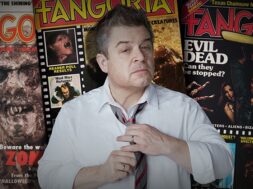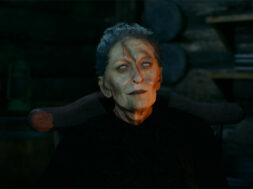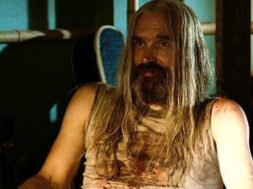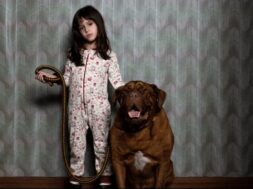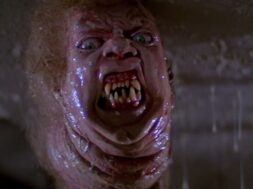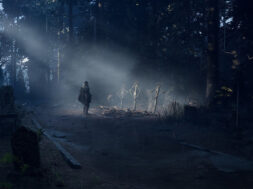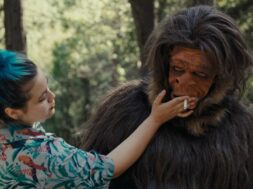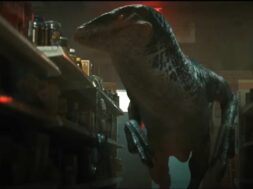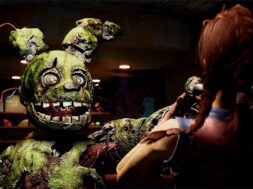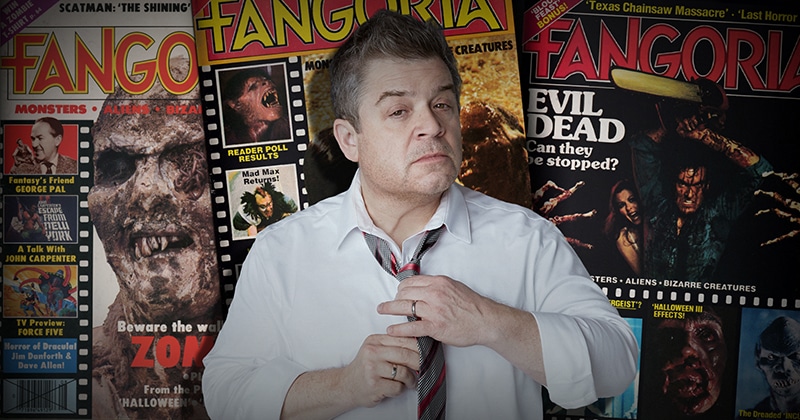
“I’m the Fango referee.”
When it comes to aficionados ― those connoisseurs of cinema (minus the pretense) ― few share as much love for the movies as Patton Oswalt. A true raconteur, he has zero shame in owning his inner geek, sharing as much love of pop culture as he does dining on the gore.
Recently, he co-created the Dark Horse comic book series Minor Threats, which is fitting. You see, readers are more than familiar with his affinity to FANGORIA and comic books when he graced the illustrated cover of Volume 2, Issue #8 back in July 2020, donning referee stripes in a homage to his original Fango competition entry from 1984 depicting the ultimate horror movie battle royale.

It’s obvious from the Oswalt gold already unearthed from the archives that you’ve always loved FANGORIA. When did you first become aware of the magazine?
I was definitely in my early teens, living in suburban Virginia. So, in terms of the films at the time, it was the case of a friend having the first VCR on the block and starting to rent movies. FANGORIA was one of the first publications you owned to claw at things you were not supposed to be seeing. A lot of times you couldn’t see the movies, and you were trying to piece together what they were from the stills that were published. That was your best recourse to figure out what the hell the movie was.
Which always added to their mythic status.
Exactly. I remember I had a book called Midnight Movies and it was the first time that I saw stills of films like Eraserhead, Pink Flamingos, and El Topo; just putting them together out of context was like, “What is this movie, this looks amazing!” I’d also read Stephen King’s Danse Macabre around those early Fango days, so I knew titles of movies like Halloween and The Texas Chain Saw Massacre, but not all of them were easy to come by. As I became more aware of that world of horror, I found the splatter films and other stuff like that via these specific issues I selected.
They really landed with me, and picking up and reading FANGORIA became a regular thing. The imagery was potent and that potency of the images fed the imagination; you got your money’s worth because that anticipation was part of the entertainment of the movies back then. That’s what was amazing later on about reading that article in issue #19 about The Road Warrior and being immediately grabbed by those images of Max, the Gyro Captain, and some of Humungus’ men twirling this weird boat hook. There was just something so incredible, and then you see the movie and it’s even better than the article, visually incredible. I wasn’t ready for it to be that good.
In terms of your curation, was it the films or the memories of the covers that influenced your choices?
It was absolutely the memories of the covers. It was also ― as with issue #19 ― that little side window of The Road Warrior. That article has always stayed with me. Then, there is The Evil Dead cover of issue #23; the layout of that article is amazing, and the fact that Stephen King (I was a massive King head) was trumpeting this movie. It was as much about those connections where you felt King was talking to a kid in the suburbs who would normally not have access to this and him going, “Find this, go seek this out.” That’s an amazing moment. I remember watching it on video and just being blown away and immediately becoming a fan of Sam Raimi.
And Stephen King still champions. It’s a beautiful thing to witness; going back to his own childhood and Danse Macabre, his love of cinema has always been there. He gives so much back.
Yeah, he still keeps those fires burning while remaining open and forgiving, which I love. But, also, he more than understands that cinema is a spin of the fortune wheel.

The selected issues share some interesting crossover and connective tissue as the magazine holds onto the ’70s and finds its feet in the ’80s.
Issues #19 and #23 were the ones I remember reading over and over and over again, but it’s great you bring that up about “finding its feet” as, having gone through the archives and looking at the covers, I’m very curious about issue #8. I would love to read an oral history of the magazine because, through issues #1 to #7, FANGORIA seemed to be hedging its bets and felt more similar to the likes of Starlog and Cinefantastique. Issue #8 is where it went, “We’re owning the gore.” Showing all those effects, they really came out of their cocoon and became their own thing.
Absolutely. They have The Shining before in issue #7, but that still feels rather safe in hindsight.
And the way into The Shining is Stanley Kubrick. “Hey, that’s the guy who made 2001!” They’re still trying to be in a more respectable world of science fiction. Someone there saw a whole other thing happening and grabbed it by the balls. “You know, we’re not Starlog… we’re not even Famous Monsters. This is what we are now.” Issue #8 feels like a blossoming. It feels like a coming-out party. I mean, just from the title of “Fan-gore-ria”. Genius.
Is there anything specific you want to weigh in on with Lucio Fulci’s Zombie?
I came to it much, much later, and I have to admit it wasn’t as great as that picture. This is the thing, there are a lot of those movies back then that had incredible covers in FANGORIA and poster art, often based on one amazing shot from the film. But then the movie itself didn’t always live up to that.
The choice of the film is an interesting one, too with Zombie already over a year old after its Italian release in August ’79. It brings in the threads of exploitation movies and Euro horror.
I just remember seeing that cover ― the close-up on the zombie’s face ― and thinking, oh, they went one further than Romero. Okay, you can look at it as an unofficial Dawn of the Dead sequel, but Lucio Fulci and Giannetto De Rossi (smartly) thought about if a body had rotted, then there would be worms eating away at it while this corpse walks around. That’s cool.
The cover shows off the makeup effects for the first time. Skip forward to issues #13 and #19 and there’s coverage on The Beast Within, a movie that is basically a setup to a special effect. It makes you realize all the more that, for a while, the makeup effects were as valuable on a poster as the actors or directors. It was all about these incredible artists such as Tom Savini, Rick Baker, and Rob Bottin.
The “Wizards of Gore”.
Yes! These were the guys that did this, this and this. Whether the film was a masterpiece or complete trash, you didn’t care; you were watching these incredible stunts.

Is Poltergeist the greatest American ghost movie of all time?
It’s the most entertaining ghost movie of all time, that’s for sure. But, in terms of “greatest”, I would say, for me, it’s a tie between The Sixth Sense and the 1960s version of The Haunting, two films that explore how ghosts affect the living. The idea at the heart of The Sixth Sense was revolutionary as you realize there is a much bigger thing going on, that a main character is, in fact, a haunting and not the haunted.
Of course, it’s similar to what is happening in Hill House, where Eleanor is haunted by a ghost who doesn’t know they’re a ghost yet. Therefore, both stories are about characters who are consumed psychologically. That’s why I feel they are better ghost stories. Poltergeist is a fucking amazing thrill ride, but they don’t get into the metaphysics of it all, it’s just these great set pieces and a really fun horror movie.
How was it ever originally a PG?
I know! There’s the gore, but then just this classic sheer fucking terror. That clown toy that comes to life! It really tapped into things with me living in Virginia with the thunderstorms and the trees outside my window, as though one of the branches was going to reach through. Hooper and Spielberg were like, “Let’s fucking do that!” Amazing. It’s basically an Indiana Jones movie with more ghosts. Naturally, they have the same Spielberg DNA but if you watch Hooper’s Fun House ― even the original Texas Chain Saw Massacre ― he was no stranger to set pieces and was more than willing to do the big honking terrifying spectacle, which was all part and parcel of what he was doing in Poltergeist.
But, “By the director of The Texas Chain Saw Massacre” was in no way going to sell that film at the time.
Nooooo… but, probably in another ten years, that would have absolutely sold it, “Oh fuck, yeah. Give that guy a shitload of money and let’s see what he does!” [laughs]
Bob Martin’s “On Location With The Thing” is an interesting read. The article reveals little of the creature and helped retain the mystery along with a genuine sense of isolation on set in British Columbia.
Makes me think of the trailer. If I recall, I think it only had one effects shot, which made it way creepier. One of the best trailers ever… the last thing you hear with the radio static. My god.
Safe to say we measure most horror movies against John Carpenter’s The Thing. Benchmark.
I mean, it’s bleak, but what’s so amazing to me now is that as gory as the movie feels, it’s so charming and sentimental. That’s a rare type of filmmaking. Today, I can only think of Canadian filmmakers, Steven Kostanski and Jeremy Gillespie who did The Void together. They capture a similar nostalgia, to a fault, and they have gone full tilt with the practical effects. I also love Kostanski’s Psycho Goreman. Again there’s a charm and sentimentality to it, especially how it leans so heavily into the goofball. Off camera, from the kids’ point of view, it’s just a big hose spraying liquid on grownups. It’s friggin’ hilarious.

With its gestation period and distribution, premiering in ’81, it took a while for The Evil Dead to be released. But, 1982: what a year for audiences to finally see it.
One of the last years where the major studio films were trying new things… and while all of that is going on there’s the future of cinema with the likes of Sam Raimi, the Coens, and that whole crew. That’s a miraculous time to be a moviegoer.
What do you feel The Evil Dead captured, and what separates it from other horror movies throughout the decade?
The Evil Dead captured something that happens every now and then: when things get big and bloated, and then someone comes along and has to remind everyone, “No, you can do this with no money.” And it’s that attitude and sheer tenacity of the “no money” and the no stars that make it seem more real. Weirdly enough, there are similar parallels with music where rock and roll became massive through prog rock ― bloated Zeppelin bloated Yes, bloated Emerson, Lake & Palmer ― and then the friggin’ Ramones come along. In movies, you have these huge big budget vehicles, but then New Hollywood happens and, most importantly for horror at the time, The Texas Chain Saw Massacre comes along and it just turns everyone’s head around.
Where The Texas Chain Saw Massacre feels like this iconoclastic horror on the fringes of New Hollywood and antithesis to studio movies, The Evil Dead was doing the same in the wake of the summer blockbusters: that decade’s Chain Saw.
Yep. Post-Chain Saw it gets big and bloated with The Omen and the Jaws rip-offs, and then John Carpenter starts it all again with Halloween. But there’s always someone with no money or resources who has to be more creative, and Raimi thrived on that. I remember, as quoted in the article, Stephen King specifically said that The Evil Dead was, “The most ferociously original horror film of the year.”
It’s almost like you have to get “ferocious.” You have to get a little bit mean about it. “No, we don’t have any fucking money, so what we’re going to do in lieu of having a massive star, we’re just going to scare the living shit out of you.” Roger Ebert once said that Halloween, in particular, is “just a machine designed to scare you.” It’s pure in purpose, as is The Evil Dead.
From pure horror to pure comedy, there was so much notoriety around the Evil Dead films, especially before they embraced the slapstick.
Evil Dead II is a Three Stooges film. Raimi leaned into the fact that he couldn’t top the original in terms of fear, so he added a whole other element that you don’t see coming. Then, in Army of Darkness, he combines them both so perfectly. Again, it’s like a precursor to what Edgar Wright brought us with Shaun of the Dead, which is equally scary and funny, and often in the same moment.
Also a lot of parallels with Peter Jackson’s early work.
Jackson was definitely able to walk that line. At the end of the day, getting a laugh or a scream is the same thing. They’re both physical reactions to a movie.
What an issue, even the Dick Miller retrospective, Mick Garris’ transcribed “Fear on Film” panel discussion with Carpenter, Cronenberg, and Landis, The Road Warrior article…
It’s a standout issue and demonstrates how FANGORIA genuinely got me hooked. It still had this vibe that the people they were interviewing were like, “Well, it’s just this little magazine…” so they come across as more forthcoming in some of the reads. When you reread The Road Warrior article, they’re interviewing producer Byron Kennedy, and it becomes clear that this is their attempt to break out of the Ozploitation prison and start doing American movies.
It feels like there’s a lot of PR going on in those interviews. It sounds like: “Oh, I know everyone thinks the stunts are crazy, but that’s done all through the editing. There were actually no accidents working on this film. Nope. No accidents. We were very, very safe.” Then if you watch the making of The Road Warrior, people were getting massacred in that friggin’ thing.
In the FANGORIA interview, they’re like, “We gotta make people not think we’re fuckin’ crazy because we’d like to work in Hollywood.” It’s brilliant. Not that I want people to die for my entertainment, but there seems to be only one guy going that far today. [It’s at this point we both disappear down a Tom Cruise-sized rabbit hole… and for all the right reasons.]
Considering you entered a Fango competition yourself, we have to mention the results of The Thing competition, “Everything Is Beautiful in its Own Way…”. Shows how connected FANGORIA was with their fanbase and how inherent that still is with the brand today.
Each editor, from the late Bob Martin to Phil Nobile Jr., is a fan of not just the magazine, but of that specific genre. FANGORIA has always been the champion for horror, even when the genre was kind of in the weeds for a few years. Now it’s becoming an important resource for a lot of young up-and-coming filmmakers. Let’s not forget that in a lot of these interviews, they accidentally compiled and collated an instruction manual on how to do amazing practical effects.
In some of those discussions, they just talk about, “Oh, we didn’t have that thing we needed so we just kind of put a lightbulb in there…” You can see a lightbulb moment where they figure it all out in The Evil Dead: “Yeah, we just had a big wobbly board with the camera in the middle of it, and we ran into the woods… we watched the footage and it looked amazing!” Yeah… do more shit like that!
Magic. I mean, you looked at those covers as a kid and saw the gross imagery, but inside, the craft was revealed.
That amazing craftsmanship behind the gore; someone wrote something impossible into a script and another person found a way to make it possible. I remember reading Tom Savini’s book, and his approach was literally old theater tricks, stuff they would do in the Grand Guignol where you’d have Kevin Bacon get stabbed in the throat. “Well, you put his head here and have a false body… and boom!” On film, it looks fucking crazy, but it’s actually very simple. It’s just how you create the atmosphere so when that happens, the audience loses their shit.
And on top of all this glorious gore, these films often have something more to say.
Horror is always a way to smuggle in topics and conversations that straight movies often just can’t touch. It’s just too much to look at it straight on to create any metaphor. I mean, when you’re a little kid watching a Frankenstein movie, ghosts, and the seasonal thrill of Halloween, that’s a way for kids to deal with their fear of death and how they can’t articulate it, so they do it through their imagination with monsters.
As you get older, there are still real fears, but how do you deal with them? Harlan Ellison once said something to the effect of, “Yes, vampires and zombies are all very scary, but you know what we’re most scared of? You go to the ATM and it won’t accept your card, or you wake up one morning and there’s a weird bump on your arm that wasn’t there the day before.” Those moments are the weird real-life things where fucking reality comes apart. Now that scares us.
For more Patton, check out Ghostbusters: Frozen Empire now in theaters. You can dig through the FANGORIA archives yourself for a bit of your own custom curation.
